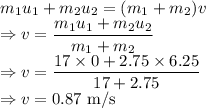
I'm out playing near a frozen pond. On the pond is a block of ice (initially at rest) with mass 17.0 kg . I slide a different ice block of mass 2.75 kg so that it collides with the stationary block. Just before impact (long after I stopped pushing it), the moving block has speed 6.25 m/s . Ignore friction with the pond. When the blocks collide they stick together and move off as a unit.
Required:
What is the change ÎK=KfinalâKinitial in the block-snowball system's kinetic energy due to the collision?

Answers: 2


Other questions on the subject: Physics

Physics, 21.06.2019 17:20, calibaby1220
The momentum of an isolated system is conserved a) only in inelastic collisions. b) only in elastic collisions. c) in both elastic and inelastic collisions
Answers: 2

Physics, 22.06.2019 03:40, AkramMasoud
Which types of electromagnetic waves have higher frequencies than the waves that make up ultraviolet light? check all that apply. radio waves infrared light microwaves gamma rays visible light x-rays
Answers: 2

Physics, 22.06.2019 05:30, GreenHerbz206
Could someone . i have tried to solve myself but my calculation is off
Answers: 3
You know the right answer?
I'm out playing near a frozen pond. On the pond is a block of ice (initially at rest) with mass 17.0...
Questions in other subjects:


Health, 27.03.2021 08:40

English, 27.03.2021 08:40

Geography, 27.03.2021 08:40

Mathematics, 27.03.2021 08:40

Chemistry, 27.03.2021 08:40


Biology, 27.03.2021 08:40


Mathematics, 27.03.2021 08:40


 = Mass of block at rest = 17 kg
= Mass of block at rest = 17 kg = Mass of moving block = 2.75 kg
= Mass of moving block = 2.75 kg = Velocity of block at rest = 0
= Velocity of block at rest = 0 = Velocity of moving block = 6.25 m/s
= Velocity of moving block = 6.25 m/s




